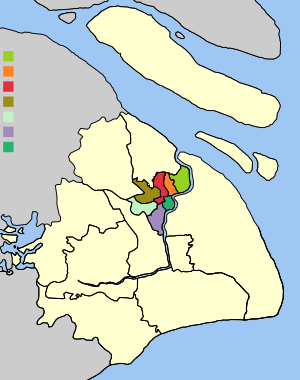
Chongming District is northernmost district of the provincial-level municipality of Shanghai. Chongming consists of three low-lying inhabited alluvial islands at the mouth of the Yangtze north of the Shanghai peninsula: Chongming, Changxing, and Hengsha. Following its massive expansion in the 20th century, Chongming is now the 2nd-largest island administered by the People's Republic of China and the 2nd-largest in Greater China, after Hainan. Chongming does not, however, administer all of the island: owing to its continual expansion from sediment deposited by the Yangtze, it has merged with formerly separate islands and now includes Jiangsu province's pene-exclave townships of Haiyong and Qilong. Chongming proper covers an area of 1,411 km2 (545 sq mi) and had a population of 704 000 at the time of the Sixth National Census in 2010.

Pudong is a district of Shanghai located east of the Huangpu, the river which flows through central Shanghai. The name Pudong was originally applied to the Huangpu's east bank, directly across from the west bank or Puxi, the historic city center. It now refers to the broader Pudong New Area, a state-level new area which extends all the way to the East China Sea.

Taicang is a county-level city under the jurisdiction of Suzhou, Jiangsu province, China. The city located in the south of the Yangtze River estuary opposite Nantong, being bordered by Shanghai proper to the south, while the river also delineates much of its northeastern boundary along Chongming Island.

Nanhui District, formerly romanized as Nanhwei, was a district of Shanghai until it was merged into Pudong New Area in May 2009. It had a land area of about 809.5 km2 (312.5 sq mi) and a 59.5 km (37.0 mi) coastline. The population of Nanhui was 975,017 as of August 2006. On May 6, 2009, it was announced that the State Council of China had approved the proposal to merge Nanhui District into Pudong, which is also a district of Shanghai.

Songjiang is a suburban district of Shanghai. It has a land area of 605.64 km2 (233.84 sq mi) and a population of 1,582,398 (2010). Owing to a long history, Songjiang is known as the cultural root of Shanghai.

Nantong is a prefecture-level city in southeastern Jiangsu province, China. Located on the northern bank of the Yangtze River, near the river mouth. Nantong is a vital river port bordering Yancheng to the north; Taizhou to the west; Suzhou, Wuxi and Shanghai to the south across the river; and the East China Sea to the east. Its population was 7,726,635 as of the 2020 census, 3,766,534 of whom lived in the built-up area made up of three urban districts.

Chongming, formerly known as Chungming, is an alluvial island at the mouth of the Yangtze River in eastern China covering 1,267 square kilometers (489 sq mi) as of 2010. Together with the islands Changxing and Hengsha, it forms Chongming District, the northernmost area of the provincial-level municipality of Shanghai. At the time of the 2010 Chinese census, its population was 660,000.

Qidong is a county-level city under the administration of the prefecture-level city of Nantong in southeastern Jiangsu province, China. It is located on the north side of the Yangtze River opposite Shanghai and forms a peninsula jutting out into the East China Sea. It has a population of 1.12 million.

Shanghai has an expansive grade-separated highway and expressway network consisting of 16 municipal express roads, 10 provincial-level expressways, and 8 national-level expressways. Three municipal expressways and four provincial-level expressways are also under construction.

Cixi, alternately romanized as Tzeki, is a county-level city under the jurisdiction of the sub-provincial city of Ningbo, in the north of Zhejiang province, China. As of the 2020 census, its population was 1,829,488. Its urban agglomeration built-up area, largely contiguous with Cixi plus the county-level city of Yuyao, had 3,083,520 inhabitants.

The Port of Shanghai, located in the vicinity of Shanghai, comprises a deep-sea port and a river port.

The Shanghai Yangtze River Tunnel and Bridge is a bridge–tunnel complex across the south fork of the Yangtze River near the river mouth in Shanghai. The tunnel connects the Pudong District of Shanghai on the south bank of the river with Changxing Island, while the bridge connects Changxing Island with Chongming Island. In combination with the Chongqi Bridge, which connects Chongming Island to the north bank of the Yangtze, the bridge–tunnel complex forms the final crossing of the Yangtze before it empties into the East China Sea.
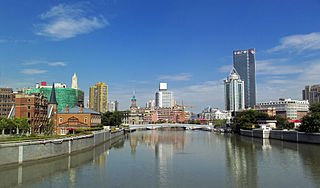
Suzhou Creek, also called the Wusong (Woosung) River, is a river that passes through the Shanghai city center. It is named after the neighboring city of Suzhou (Soochow), Jiangsu, the predominant settlement in this area prior to the rise of Shanghai as a metropolis.
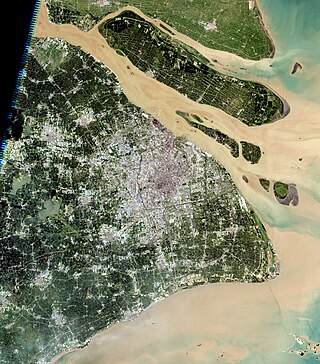
The islands of Shanghai are those under the jurisdiction of the Shanghai municipal government. They comprise three large inhabited islands and a shifting number of smaller, uninhabited ones. Most are alluvial islands in the Yangtze River Delta in China, although a number of islands in Hangzhou Bay off Jinshan District are also administered by Shanghai. The alluvial islands are relatively young and their number varies over time. In 2006, the city's 19 uninhabited islands covered 226.27 square kilometers (87.36 sq mi), with a total coastline length of 309 kilometers (192 mi).
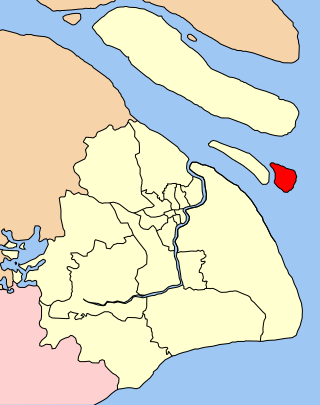
Hengsha is a low-lying alluvial island at the mouth of the Yangtze River in eastern China. Together with the islands of Chongming and Changxing, it forms Chongming District, the northernmost area of the provincial-level municipality of Shanghai. Its population was 33,400 in 2008.

Shengsi County is a county in the northeast of Zhejiang province consisting of an archipelago islands located to the east of Hangzhou Bay. It is under the administration of Zhoushan City and is the easternmost county-level division in the province. The islands of Greater and Lesser Yangshan are connected with Shanghai's Pudong New Area by the Donghai Bridge and their port forms part of the Port of Shanghai. They are, however, not counted among the islands of Shanghai.

The Shenyang–Haikou Expressway, designated as G15 and commonly referred to as the Shenhai Expressway is an expressway in China that connects the cities of Shenyang, Liaoning, and Haikou, Hainan. When fully complete, it will be 3,710 km (2,310 mi) in length. One of its oldest portions is the Shenyang–Dalian Expressway, or Shenda Expressway is a 400 km (250 mi) expressway that connects Shenyang and Dalian, the two largest cities of China's Liaoning province.
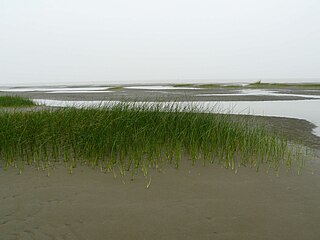
Jiuduansha is a collection of four intertidal wetland shoals at the mouth of China's Yangtze River. They are administered as an island region of the municipality of Shanghai's Pudong New Area.
Haiyong is a town of Haimen District in Nantong, Jiangsu, China. Together with neighboring Qilong, it forms a pene-enclave of the province on Chongming Island, most of which belongs to the province-level municipality of Shanghai. Haiyong presently covers about 12.5 square kilometers (5 sq mi) and had a population of 5,004 during the year 2000 census.



